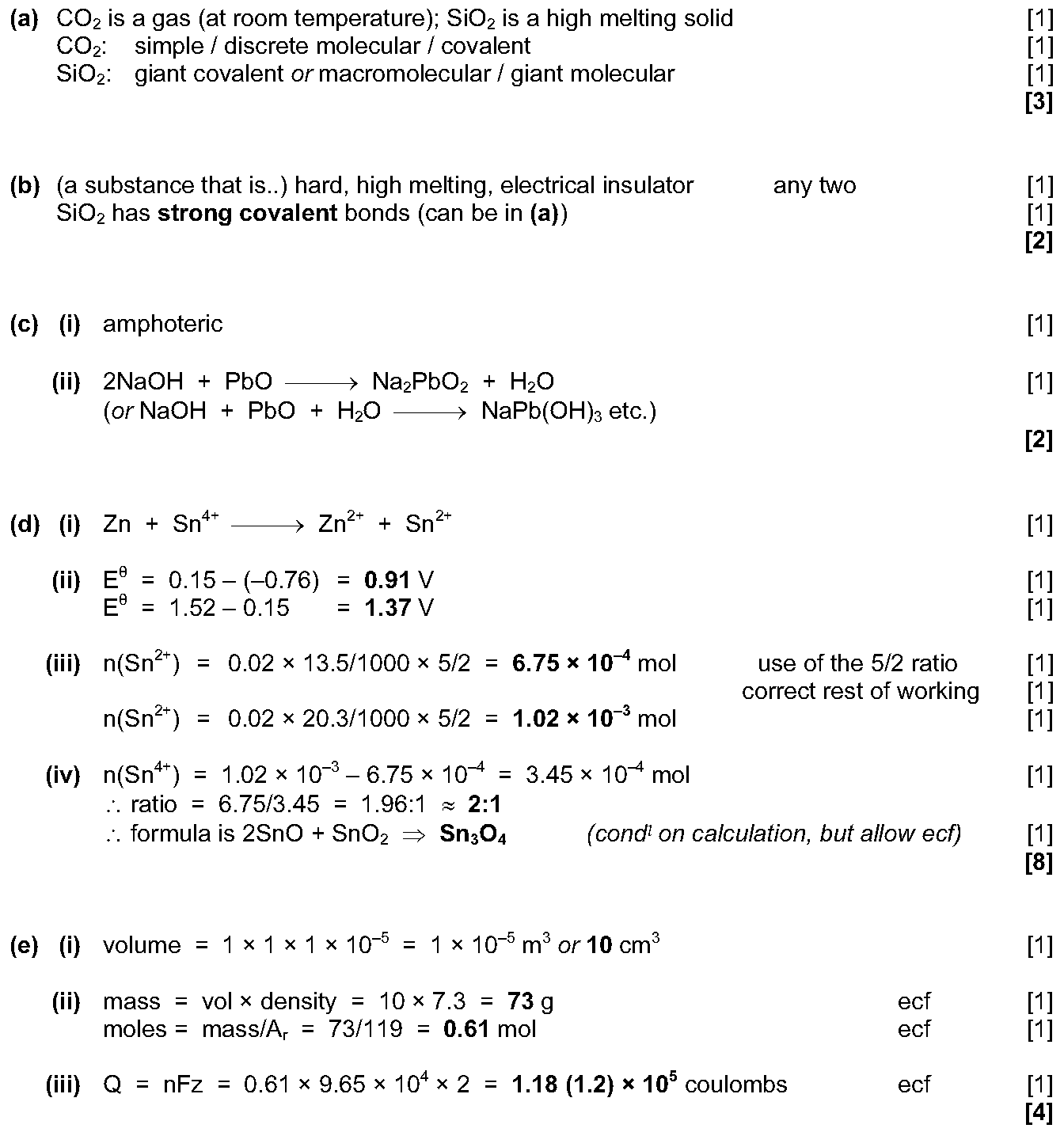
Q1:
AS & A Level Chemistry - 9701 Paper 4 2009 Winter Zone 1
Questions:
1/9

Topic: CH6 - ELECTROCHEMISTRY
Solution



PRACTISE
Similar Questions

LEARN
Concepts with Sparky

More Questions from this Topic
Theory
CH6 - ELECTROCHEMISTRY
Bismuth is an element in Group 15 of the Periodic Table.(a) Bismuth has metallic bonding.Draw a labelled diagram to show the metallic bonding in bismu...
2024
 Spring
Spring
 Spring
Spring
 4
4
Theory
CH6 - ELECTROCHEMISTRY
(a) A and B react together to give product AB.A + B → ABWhen the concentrations of A and B are both 0.0100 mol dm−3, the rate of formation of AB i...
2024
 Winter
Winter
 Winter
Winter
 3
3
Theory
CH6 - ELECTROCHEMISTRY
(a) Explain why transition elements form complex ions. .................................................................................................
2024
 Winter
Winter
 Winter
Winter
 3
3
Theory
CH6 - ELECTROCHEMISTRY
Potassium iodide, KI, is used as a reagent in both inorganic and organic chemistry.(a) KI forms an ionic lattice that is soluble in water.(i) Define e...
2024
 Spring
Spring
 Spring
Spring
 4
4
Theory
CH6 - ELECTROCHEMISTRY
(a) (i) Lithium nitrate, LiNO₃, decomposes on heating in a similar way to Group 2 nitrates to give the metal oxide, a brown gas and oxygen.Write an ...
2024
 Summer
Summer
 Summer
Summer
 3
3
Theory
CH6 - ELECTROCHEMISTRY
(a) (i) Define transition element........................................................................................................................
2024
 Summer
Summer
 Summer
Summer
 5
5
Theory
CH6 - ELECTROCHEMISTRY
(a) Equation 1 shows water acting as a Brønsted–Lowry acid. equation 1 \[ \text{H}_2\text{O} + \text{NO}_2^- \rightleftharpoons \text{HNO}_2 + \tex...
2024
 Spring
Spring
 Spring
Spring
 2
2
Theory
CH6 - ELECTROCHEMISTRY
(a) When a sample of hydrated lithium ethanedioate, $\text{Li}_2\text{C}_2\text{O}_4 \cdot \text{H}_2\text{O}$, is gently heated, two gaseous products...
2024
 Summer
Summer
 Summer
Summer
 2
2
Theory
CH6 - ELECTROCHEMISTRY
(a) Define standard electrode potential, $E^\text{o}$, including a description of standard conditions.(b) (i) An electrochemical cell is set up to mea...
2024
 Summer
Summer
 Summer
Summer
 3
3
Theory
CH6 - ELECTROCHEMISTRY
(a) The equation for reaction 1 is shown.reaction 1\qquad X \rightarrow 2YReaction 1 is first order with respect to the concentration of X. The half-l...
2024
 Winter
Winter
 Winter
Winter
 2
2
More Questions from year 2009
Theory
CH1 - ATOMS, MOLECULES & STOICHIOMETRY
Copper and titanium are each used with aluminium to make alloys which are light, strong and resistant to corrosion. Aluminium, $Al$, is in the third p...
2009
 Summer
Summer
 Summer
Summer
 2
2
Theory
CH10 - GROUP 2
Magnesium will react on heating with chlorine, or oxygen, or nitrogen to give the chloride, or oxide, or nitride respectively. Each of these compounds...
2009
 Summer
Summer
 Summer
Summer
 2
2
Theory
CH15 - HYDROCARBONS
Concern over the ever-increasing use of fossil fuels has led to many suggestions for alternative sources of energy. One of these, suggested by Profess...
2009
 Summer
Summer
 Summer
Summer
 2
2
Theory
CH22 - ANALYTICAL TECHNIQUES
(a) Complete the following reaction scheme which starts with ethanol.In each empty box, write the structural formula of the organic compound that woul...
2009
 Summer
Summer
 Summer
Summer
 1
1
Theory
CH22 - ANALYTICAL TECHNIQUES
(a) When F is formed in step I no other compound is produced. Suggest a structural formula for F, which contains one –OH group.(b) Compound G has tw...
2009
 Summer
Summer
 Summer
Summer
 2
2
Theory
CH1 - ATOMS, MOLECULES & STOICHIOMETRY
(a) Complete the electronic configuration of aluminium and of titanium, proton number 22.\[\begin{array}{|c|c|}
\hline
\text{Al} & 1s^2 \\
\hline
\tex...
2009
 Summer
Summer
 Summer
Summer
 2
2
Theory
CH10 - GROUP 2
(a) (i) Write an equation, with state symbols, for the second ionisation energy of calcium...............................................................
2009
 Summer
Summer
 Summer
Summer
 1
1
Theory
CH15 - HYDROCARBONS
Concern over the ever-increasing use of fossil fuels has led to many suggestions for alternative sources of energy. One of these, suggested by Profess...
2009
 Summer
Summer
 Summer
Summer
 2
2
Theory
CH22 - ANALYTICAL TECHNIQUES
(a) Complete the following reaction scheme which starts with propanone. In each empty box, write the structural formula of the organic compound that w...
2009
 Summer
Summer
 Summer
Summer
 2
2
Theory
CH22 - ANALYTICAL TECHNIQUES
Ethanol, CH$_3$CHO, can be converted into compound U by the following sequence.(a) When T is formed in step I, no other compound is produced.Suggest a...
2009
 Summer
Summer
 Summer
Summer
 2
2




 Share
Share




 Previous
Previous



